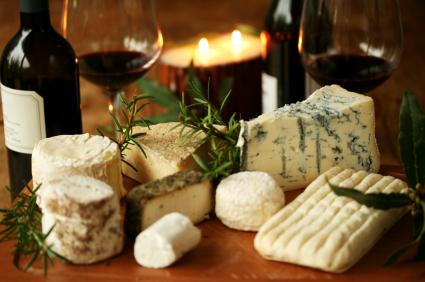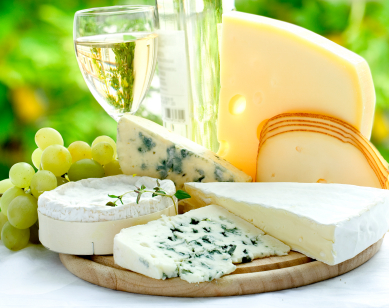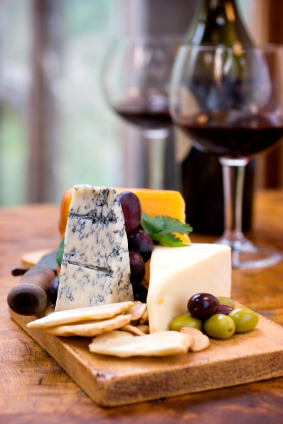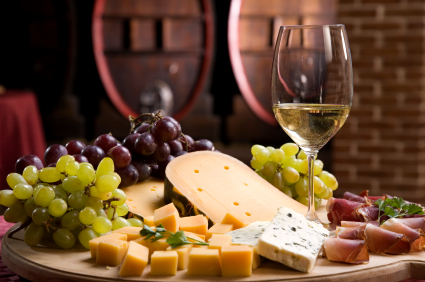By: John St. Mark
Wine and cheese. The combination is ubiquitous, so they must go together … right?

Wine and cheese do have a great deal in common. Both are fermented, complex, and very ancient foods. Just as wine can be made from different grape varieties, cheese can be made from the milk of different animals. Where the grapes are grown and how they are cultivated will affect the wine and similarly, where the animals live and what they eat will affect the cheese. In both cases, the methods and materials used by the producer will determine many features of the finished product.
When tasted together, each can influence our perceptions of the other significantly; for that reason, professionals in both industries normally do not like to see wine and cheese together in an analytic tasting. Their goal is to evaluate the wine or the cheese based on its own merits.
Tasting for enjoyment is another matter. If we have wine and cheese together, we want the interactions between them to be interesting and pleasant, so let’s consider some of the factors that influence those interactions. For now, let’s look at the following six attributes of wine:
• Acidity in wine can cut the richness, fattiness, oiliness or saltiness of some cheeses. It can match the tartness in cheese and bring out simple, pleasant flavors.
Generally, one finds higher acidity in wines made from grapes grown in cooler climates, harvested at an earlier stage of ripeness. If the acidity is too high the wine may taste tart; if acidity is lacking the wine is said to be "flabby."
The overall acidity of some wines is lessened by malolactic fermentation, which converts malic acid into softer lactic acid and releases energy in the process, so the total acidity is lowered. This is the case with most reds; with whites it varies depending on the style and the winemaker’s preference. A buttery-tasting chardonnay has probably undergone malolactic fermentation, whereas a crisp sauvignon blanc probably has not.
• Sweetness in wine can take the edge off tartness, compliment sweetness, or contrast with saltiness in cheese.
In winemaking, the fermentation process essentially converts sugar into alcohol. Wine is said to be dry if all (or very nearly all) of the sugar has been metabolized; a wine will retain sweetness if there is still sugar present. This may be simply because it is not fully fermented (as with off-dry Riesling) or because it has been fortified with some distilled wine, thereby halting the fermentation at the desired sugar level (as with Port) or because the sugar concentration in the grapes is especially high prior to fermentation due to dehydration (as with Sauternes when the botrytis fungus extracts moisture from the fruit) or the removal of water in the form of ice (with ice wines) so that fermentation stops naturally before all the sugar is gone.

Bear in mind that a wine may be both sweet and highly acidic (as is often the case with sweet wines from cool climates.) This combination will keep acidic wines from tasting sour, and keep sweet wines from being cloying.
• Alcohol in wine is, to some extent, analogous to fat content in cheese; higher alcohol wines seem fuller-bodied and more viscous. Often wines with high alcohol content will balance well with rich, fatty cheeses. Excessively high alcohol can cause a burning feeling, however (a milder version of what one might get from hard liquor) and that sensation can be amplified by spicy or salty foods. If the high alcohol seems out of balance, the wine may be described as "hot."
The alcohol content of a dry wine will be dependant on the sugar content in the fruit it is made from, and sugar development will depend on heat and sunlight. Therefore, wines from warmer growing regions will tend to have higher alcohol than wines from cooler regions.
• Tannin creates astringency in wine and can cause a sensation similar to that of bitterness. This can compliment the bitterness in some cheeses, and can counter-balance fat and protein very effectively.
The principal source of tannin in wine is the grape skins. Red wines macerate with the skins for an extended period of time and white wines typically do not, so tannin is more of a factor with reds (tannin can also be extracted from oak barrels, so oak-aged whites may also have perceptible tannin.) The skin of red grapes is also the source of color in red wine, so very generally deep-colored red wines are more tannic.
Tannins are unstable, and will bond aggressively with other compounds. In your mouth, they can bond with the proteins in saliva, creating a dry, gritty sensation (astringency.) As the wine ages, the tannins will bond with other compounds in the wine, including the polyphenols responsible for color, so as the color fades from purplish-red to reddish-brown, the tannins will become less perceptible. So, older red wines will have softer tannins than younger reds.
• Oak contributes additional complexity to wine, and can complicate food pairing if the oak dominates the wine’s fruit characteristics.
 Not all wines are aged in oak barrels, and not all barrel-aged wines have strong oak flavor. If the oak is evident, it can vary in quality and by degree. Oak flavors should not be too "woody" but may be reminiscent of toast, nuts, vanillin, mocha, clove, chocolate, or caramel, for example.
Not all wines are aged in oak barrels, and not all barrel-aged wines have strong oak flavor. If the oak is evident, it can vary in quality and by degree. Oak flavors should not be too "woody" but may be reminiscent of toast, nuts, vanillin, mocha, clove, chocolate, or caramel, for example.
• Age will generally lead to more subdued fruit, softer tannins (in reds) and sometimes to more earthy or gamey character.
Young wines will tend to have bolder, fruitier flavor, whereas older wines (that have aged well) will tend to be mellower, with more integrated flavors.
So, what about the cheese? Like wines, cheeses can vary greatly even within specific categories. Not every chardonnay tastes the same, nor does every brie; general flavor profile, acidity, saltiness, maturity, even the sort of milk used may be different. With that said, here are the basic categories of cheese:
• Fresh or Soft cheeses (like Feta or Ricotta)
• Semi-soft cheeses (like Monterey Jack or Havarti)
• Semi-hard cheeses (like Swiss or Gruyere)
• Hard cheeses (like Parmigiano-Reggiano or Dry Jack)
• Blue cheeses (that are veined with mold, like Roquefort, Gorgonzola or Stilton)
• Soft-ripened cheeses (that are ripened by mold, like Brie or Camembert)
• Washed-rind cheeses (that are ripened by bacteria; these are the stinky ones)
When you consider pairing wine with cheese, you may want to match wines and cheeses with similar characteristics. For example, a light fresh cheese might go nicely with a light, fresh (acidic) wine, or a dense oily cheese might go with a heavier (higher alcohol) wine. Or, maybe an older wine might pair well with an aged cheese that shares its earthy, gamey flavors. You might think about geographic origin, pairing wines and cheeses that come from the same place. Another option you may enjoy is to contrast wines and cheeses with opposing characteristics, like matching a sweet wine with a salty cheese.
Any of these pairing criteria could also be used to put together a set of cheeses or wines to try together. As a general rule, if you taste in sequence, you should start mild and light and go toward strong and rich (the same principle applies to wine and to cheese.)
If you’re serving wine and cheese as an appetizer, don’t overdo it; cheese can be very filling! You’d probably be better off with lighter wines, and limiting yourself to one or two cheeses. You might consider a wine that would also pair well with the first course you will be having, especially for a smaller gathering.
If you want to have cheese after the main course, remember that nobody should be really hungry at that point, although they may be in the mood for something rich. Perhaps you’ll wish to continue enjoying the wine served with the main course, so a rich cheese that pairs well with that wine would be a good choice. If you want to pour another wine with dessert (probably a sweet or maybe a sparkling wine) then consider a cheese that will also go with that. Aged parmesan or a rich blue cheese could work well.
If the wine and cheese are the main event you’ll want more variety, but still you don’t need to be overwhelmed. I think five is a good number, and of course you’ll want a bit more quantity. Be sure to have separate knives for each cheese, and to put runny or very smelly cheeses on separate plates. It’s a good idea to have plain bread or crackers available for those who really want to taste the cheese, although there’s nothing wrong with providing additional options (flavored crackers or whatever) if they don’t clash with the cheeses. You’ll want to supply both sweet and savory garnish; consider dried or fresh fruit and olives (green olives tend to go with white wine, black olives with red) or salted nuts. If you’ve got the cheese in the refrigerator, take it out well in advance so it’s not too cold.

Here are a few ideas for classic wine and cheese pairings:
• Fresh goat cheese with Sauvignon Blanc. You should find a satisfying affinity of freshness, tartness, and herbaceousness, particularly if you choose a cooler-climate wine, say from New Zealand. This could make a great appetizer.
• Sharp cheddar and Grenache. There is a lot of bland industrial cheddar out there, and similarly there is a lot of uninteresting bulk wine produced from Grenache grapes, but at their best both can be delicious. Look for artisan cheese, and wine from one of the several regions known for quality Grenache (like the Rhone Valley in France, the Priorat region of Spain, or the Barossa Valley in Australia.)
• Dry (cured) Manchego cheese with Tempranillo wine from the Ribera del Duero region of Spain. The saltiness of the cheese should bring out the fruit in the wine, and the richness of both should be complimentary. If you haven’t tried either of these, you’re in for a treat.
• Roquefort cheese with Sauternes. The rich, pungent, salty cheese and the intense, unctuous, sweet wine make a truly classic (and decadent) pair. A couple of California alternatives to French Sauternes: Dolce from Far Niente Winery and the Sauvignon Blanc Botrytis from Robert Mondavi Winery are excellent wines produced almost next door to one another in the Napa Valley.
• Brie with Chardonnay. This pairing can hit or miss – both the cheese and the wine can vary significantly – but ideally, there should be a very gratifying affinity of creamy, buttery, nutty characteristics. Look for a barrel-aged wine from a well-regarded producer. (Chardonnay has been over planted, often in places where it does not live up to its full potential.)
These are just ideas, of course; I hope you find some of them helpful. There is a lot out there to choose from, and nothing to stop you from trying whatever appeals to you!

















Great article Kevin!
Lots of good ideas and info!
OK, so your coverage of the subject was very interesting.
But excuse me, you forgot to mention Velveeta and Cheez-Whiz! LOL